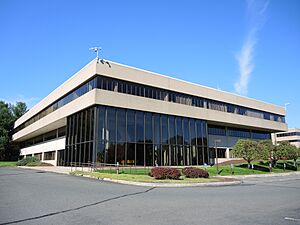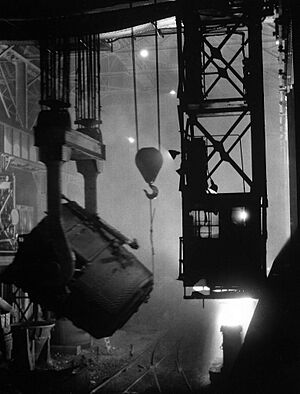Otis Worldwide facts for kids
 |
|

Headquarters in Farmington, Connecticut.
|
|
|
Trade name
|
Otis Elevator Company |
|---|---|
| Public | |
| Traded as |
|
| Industry | Transport systems |
| Predecessor | United Technologies |
| Founded | 20 September 1853 (acquired in 1976, spun off in 2020) |
| Founder | Elisha Otis (original Otis Elevator Company) |
| Headquarters | Farmington, Connecticut, U.S. |
|
Area served
|
Worldwide |
|
Key people
|
Judy Marks (President and CEO) |
| Products | Elevators and escalators |
| Revenue | |
|
Operating income
|
|
| Total assets | |
| Total equity | |
|
Number of employees
|
71,000 (2023) |
Otis Worldwide Corporation (branded as the Otis Elevator Company, its former legal name) is an American company that develops, manufactures and markets elevators, escalators, moving walkways, and related equipment.
Based in Farmington, Connecticut, U.S., Otis is the world's largest manufacturer of vertical transportation systems, principally focusing on elevators, moving walkways, and escalators. The company pioneered the development of the "safety elevator", invented by Elisha Otis in 1852, which used a special mechanism to lock the elevator car in place should the hoisting ropes fail.
The Otis Elevator Company was acquired by United Technologies in 1976, but it was spun off as an independent company 44 years later in April 2020 as Otis Worldwide Corporation.
Its slogan is "Made to move you".
Contents
History
The booming elevator market
In 1852, Elisha Otis invented the safety elevator, which automatically comes to a halt if the hoisting rope breaks. After a demonstration at the 1853 New York World's Fair, the elevator industry established credibility.
The Otis Elevator Company was founded in Yonkers, New York, in 1853 by Elisha Otis. When Elisha died in 1861, his sons Charles and Norton formed a partnership and continued the business. During the American Civil War, their elevators were in high demand due to the shipment of war materials. Businesses throughout the United States purchased them. In 1864, with the partnership of J.M. Alvord, the company became known as Otis Brothers & Co. In 1867, Otis opened a factory in Yonkers, New York, the city where the company was founded.
In 1925, the world's first fully automatic elevator, Collective Control, was introduced. In 1931, the company installed the world's first double-deck elevator at 70 Pine Street in New York City.
In the early 1950s, the company introduced "Autotronic", an electromechanical computer system for running a bank of high speed elevator cars, which could predict the traffic flows within a building at specific times of the day and therefore deploy the cars in the most efficient manner.
Otis opened a factory in Bloomington, Indiana, in 1965.
Fayette S. Dunn became president of the company in 1964, succeeding the late Percy Douglas.
1977 saw the introduction of "Elevonic" - the successor to Autotronic - which was the first solid state, microprocessor based elevator control system which replaced the older electromechanical relay-based systems which had been at the heart of elevator controls since the 1920s.
1980s changes
Otis was acquired by United Technologies in 1976 and became a wholly owned subsidiary. In 1981, the Yonkers factory closed, and was later purchased by Kawasaki for use as a rail car assembly plant. Also in 1981, Otis signed a business agreement with an elevator company in China and Francois Jaulin became president. In 1989 Karl J. Krapek became president of the company and was replaced in 1991 by Jean-Pierre van Rooy.
During the 1980s, Otis developed the Remote Elevator Monitoring (REM) system that collected behavioral data from 300,000 elevators.
Otis has also dabbled in horizontal automated people-mover "shuttle" systems, such as the Otis Hovair. In 2020, Otis formed a joint venture called "Poma-Otis Transportation Systems" with the French company Pomagalski to promote these products. That partnership has since ended.
1990s acquisitions
Otis Elevator Company purchased Evans Lifts in the UK when Evans Lifts Ltd went bankrupt in 1997 during its merge with Express Lift Company with the name ExpressEvans. It was the oldest and largest manufacturer of lift equipment in the UK, and was based in Leicester, England. Otis's Customer Care Centre is still based in the old Evans Lifts building in Leicester. The building has since been extended by Otis. There are some installations of Evans Lifts in use today. Few lifts made by Otis are branded as Evans. Notably, an original Evans Lift is still in the Silver Arcade in Leicester. It formerly transported people to the upper floors. The upper floors are no longer occupied: the lift is no longer used.
In 1997, Steve Page became president of Otis Elevator Co.
In 1999, Otis acquired CemcoLift, Inc, located in Hatfield, Pennsylvania. The operation was later closed in October 2012, with the remaining business being sold to Minnesota Elevator Inc.
South Korea divisions
In 1910, Otis installed the first hydraulic elevator for transporting money at the Bank of Chosun, and installed the first elevator for passengers on the Korean Peninsula at a railway hotel. Since then, almost all elevators in the Korean Peninsula have been installed before the liberation, and even after liberation, they were the first to land in the Korean market, occupying about 80% of the elevators imported from Korea.
In 1982, it re-entered the Korean market through a technological alliance with Dongyang Elevator, and in 1991 took over the elevator manufacturer Korea Engineering and launched 'Korea OTIS Elevator'. The elevators supplied at this time were brought to Korea in the form of direct imports from overseas factories.
At the time, apart from OTIS Korea, the actual predecessor of Otis Elevator was LG Industrial Systems Elevator. In 1968, Youngjin Electric and Goldstar established elevator manufacturing plants in Juan, Incheon and Changwon, Gyeongsangnam-do, respectively. After forming an alliance, Hitachi Elevator entered the Korean market in 1979 through a joint venture with Goldstar. At that time, the Juan plant had the name 'Shin Yeong Electric' and the Changwon plant had the name 'Geumseong Sa', but in 1987, Geumseong Sa changed its name to 'Geumseong Sanjeon' and Shin Yeong Electric's changed its name to 'Geumseong Sanjeon', which combined the Geumseong Electrician and Geumseong Sanjeon. It was called 'Goldstar Elevator'. In February 1995, Goldstar Industrial Systems changed its name to 'LG Industrial Systems', and in September of the same year, LG Industrial Systems merged Goldstar Industrial Systems and Geumseong Industrial Systems(Korea). Afterwards, Otis established 'Otis Korea' in a joint venture with Dongyang Heavy Industries in February 1998.
Otis also took over the shares of LG Industrial Systems Elevator in December 1999 and changed the name of LG Industrial Systems Elevator to LG-OTIS. At the same time, the existing Korea OTIS was merged with it. In 2000, LG-OTIS founded Sigma Elevator and used Sigma brand to replace LG-OTIS,LG and Goldstar Brand at Overseas (International). The company name was also changed back to OTIS-LG. After the acquisition of shares was completed in 2005, LG Industrial Systems was separated into LS Industrial Systems and the 'LG' trade name was removed to become 'Otis Elevator Korea'.
21st century
In 2002, Ari Bousbib became president of Otis.
Didier Michaud-Daniel became president of the company in 2008. In 2011, Otis acquired its competitor Marshall Elevator for an undisclosed amount. Beginning in 2011, Otis cut its manufacturing operations in Nogales and supply-chain operations in Tucson, Arizona, as part of a consolidation of manufacturing operations in Florence, South Carolina, where Otis purchased a former Maytag facility on 92 acres. As part of the consolidation, Otis shut down its Bloomington facility in 2012.
In February 2012, Pedro Sainz de Baranda was named president of the company, replacing Michaud-Daniel. In October 2013, Otis won its biggest ever contract to date, to supply 670 elevators and escalators to the Hyderabad Metro. Its second biggest contract had been in 2012, to supply 349 elevators for the Hangzhou metro. In 2015, Otis had to slow its expansion in Asia after orders in the region started to drop.
On October 9, 2017, Judy Marks was named president of Otis Elevator Company, replacing Philippe Delpech. In January 2018, Otis inaugurated the installation of the world's longest double-deck elevator (30 elevators) in the 555-meter Lotte World Tower in Seoul. The "sky shuttle" can take 54 passengers from the 2nd floor to the 121st floor in 1 minute. On November 26, 2018, United Technologies announced it would spin off Otis Elevator into an independent company. Its headquarters are to remain in Connecticut. In 2019, Otis geared up its artificial intelligence technology by capitalizing on predictive technologies.
In July 2022, Otis elevator company sold its business in Russia to S8 Capital holding. The holding received equipment, technologies and staff. In addition, the American side guaranteed uninterrupted supplies of the necessary spare parts. In early August, a new production line was launched. Since the end of January 2023, the company has been manufacturing products under the Meteor Lift brand.
Notable installations
Otis has installed elevators in some of the world's most famous structures, including:
- Eiffel Tower
- Empire State Building (modernization partnership signed in 2011)
- The original World Trade Center
- The Twilight Zone Tower of Terror Attractions (including ride mechanisms)
- Petronas Twin Towers
- Burj Khalifa
- CN Tower
- Winchester Mystery House
- Hotel del Coronado
- Demarest Building (first electric elevator)
- The Singing Tower at Bok Tower Gardens
- Skylon Tower
- 30 Hudson Yards
- Willis Tower (modernization)
- Raj Bhavan (India's first elevator)
- University of Wisconsin-Madison Memorial Union
See also
- Otis Elevating Railway
- List of elevator manufacturers




